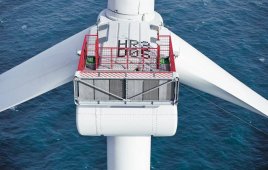Editor’s note: Although this effort in this news parallels the work of private industry, a successful outcome will allow storing economically produced excess power, wind generated and otherwise, as hydrogen which can then be used to drive fuel cells or in industrial applications. If the work is good for utilities, it is good for the wind industry.
The Energy Department (DOE) recently announced $10 million, subject to appropriations, to support the launch of the HydroGEN Advanced Water Splitting Materials Consortium (HydroGEN). This consortium will utilize the expertise and capabilities of the national laboratories to accelerate the development of commercially viable pathways for hydrogen production from renewable energy sources.

HydroGEN focuses on advanced water splitting materials, initially for the photoelectrochemical, solar thermochemical, and advanced electrolytic hydrogen production pathways.
HydroGEN is being launched as part of the Energy Materials Network (EMN) that began in February of this year, crafted to give American entrepreneurs and manufacturers a competitive edge in the global race for clean energy in support of the Materials Genome Initiative and advanced manufacturing priorities. Currently, the Office of Energy Efficiency and Renewable Energy funds research and development of low-carbon hydrogen production pathways, and by establishing HydroGEN, the DOE intends to accelerate innovation with the assistance of the national laboratories.
The new consortium is led by the National Renewable Energy Laboratory, and also includes Sandia National Laboratory, Lawrence Berkeley National Laboratory, Idaho National Laboratory, Lawrence Livermore National Laboratory, and Savannah River National Laboratory. The consortium’s newly launched website details capabilities being made available to companies, academia, and other labs, and also details mechanisms for engagement. Additional information on engaging with the consortium through DOE funding can be found in the Fuel Cell Technologies Office’s most recent notice of intent, available here.
EMN focuses on tackling one of the major barriers to widespread commercialization of clean energy technologies—namely, the integrated design, testing, and production of advanced materials. By strengthening and facilitating industry access to the unique resources available at the Energy Department’s national labs, the network will help industry bring these materials to market more quickly.
Each EMN consortium will bring together national labs, industry, and academia to focus on specific classes of materials aligned with industry’s most pressing challenges related to materials for clean energy technologies. The EMN consortia that have been launched thus far are:
- HydroGEN focuses on advanced water splitting materials, initially for the photoelectrochemical, solar thermochemical, and advanced electrolytic hydrogen production pathways.
- Hydrogen Materials – Advanced Research Consortium (HyMARC) focuses on the thermodynamic and kinetic limitations of storage materials, to create an entirely new capability that will enable accelerated materials development to improve energy storage.
- Electrocatalysis Consortium (ElectroCat) is dedicated to finding new ways to replace the platinum group metals currently used in hydrogen fuel cells with inexpensive and more abundant substitutes, such as iron and cobalt.
- Lightweight Materials Consortium (LightMat) focuses on materials that can lightweight vehicles to increase fuel efficiency, such as specialized alloys and carbon fiber-reinforced polymer composites that can be manufactured on a large scale.
- Durable Module Materials Consortium (DuraMat) focuses on durable photovoltaic (PV) module materials to further optimize reliability and capacity of low-cost PV modules.
- Caloric Cooling Consortium (CaloriCool) focuses on development of caloric materials for cooling applications.
- Chemical Catalysts for Bioenergy (ChemCat Bio) is dedicated to identifying and overcoming catalysis challenges for biomass conversion processes.
The Department’s Office of Energy Efficiency and Renewable Energy accelerates development and deployment for energy efficiency and renewable energy technologies and market-based solutions that strengthen U.S. energy security, environmental quality, and economic vitality. Learn more about the Energy Department’s broader efforts to develop affordable, efficient fuel cell and hydrogen technologies on EERE’s Hydrogen and Fuel Cells page.
Filed Under: Financing




